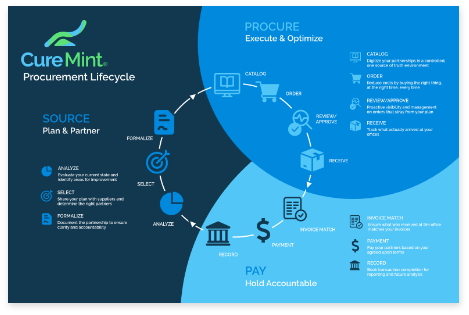At CureMint, we’re committed to saving you money as we help your dental organization reshape its supply procurement strategy. In this year’s blog series, we’ll guide you through nine easy steps to drive down your dental supply costs so you can better manage your finances and become more profitable in the dental industry.
The dental industry has witnessed remarkable sea changes in recent years. As group dentistry continues to grow and private equity seizes on investment opportunities, this market is quickly becoming a whole new ball game. With the current compression on profitability, you must utilize every tool at your disposal so you can manage your overhead while remaining competitive in this rapidly changing environment. And there are precious few avenues to cut costs while also delivering the top-notch dental care your patients expect.
Luckily, we’re here to help.
If you’re reading this, it’s very likely that the way your organization sources dental supplies is stuck in the 20th Century. Improving your sourcing process is the foundation of driving down supply costs. Removing the middleman whenever possible and streamlining your supply chain will help you save money, so you can refocus your resources on important overhead expenses and provide the best care possible.
So, let’s start this process by engaging in some simple budget analysis.
STEP ONE: ORGANIZE & FORMULIZE
Before diving into how we can help you organize and analyze your dental supply budget, here’s a farcical example of how simple this process can be from one of the most eccentric corners of the Internet: Twitter.
This may seem like an absurdly silly example, but the basic message holds true. In all walks of your life, understanding your budget is fundamental to optimizing your financial responsibility. And once you layout your spend history, ways to cut costs become glaringly simple. In this example, your organization is @dril, and your outdated method for handling your supply chain is their monthly spend on candles. Once you recognize you’re overspending on sourcing supplies, you’re en route to freeing significant capital to invest in the most important parts of your practice.
Firstly, you’ll need to organize the last 12 months of your supply spend. Start off by requesting your order history from your primary dental-supply distribution partners such as Henry Schein, Patterson, Benco, Darby, or whomever else, as well as suppliers to whom you send direct orders, like Brasseler, Komet, Ultradent, and others. You’ll need a few specific pieces of information:
- Manufacturer
- Item SKU Number
- Item Name and Description
- Item Category and Sub-Category
- Unit of Measure (ie, quantity of product per order)
- Quantity Ordered
- Product Price
When you’ve collected all the requisite information, combine and organize your 12-month spend history into an Excel spreadsheet. We call this your starter formulary — a custom consolidated supply catalog from which your office’s order products.
Here’s an example of how your formulary should look to ensure we can most smoothly import your information:

[SEE THIS FORMULARY SPREADSHEET & THE FULL 9 STEP GUIDE TO REDUCING YOUR DENTAL SUPPLY COSTS HERE]
By the end of our nine-step process, you’ll have primary and secondary formularies, and quite possibly some specialty formularies — but that time will come. As far as the here and now goes, this will be the basis of our project. It may seem daunting at first, but as we move along, your formularies will become simpler and easier to manage and navigate.
But for now, there we have it: All your most important supply expenses, all spread out and right in front of you, all for your benefit. You may find yourself surprised at where your money goes. You’ll definitely see which products are most vital to your organization, and you can use those most-important purchases as touchstones as we progress through this nine-step process.
Can’t wait for the next blog? We don’t blame you.
In fact, you’ll soon be speaking directly with your product vendors — but we’re saving that for our next installment. Keep your eyes peeled for Step Two: Request for Quotation.
Related Blogs
How to Get Started with Dental Spend Management When You Don’t Know Where to Start
09.30.21
For rapidly growing dental service organizations (DSOs), the…
Using Big Data to Lower Dental Supply Costs
09.28.21
As the dental market surpasses $150 billion and private…
Not All Dental Costs Are Equal: Which One Are You Focusing On?
09.27.21
It doesn’t matter whether you’re whitening teeth or selling…





